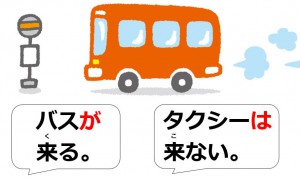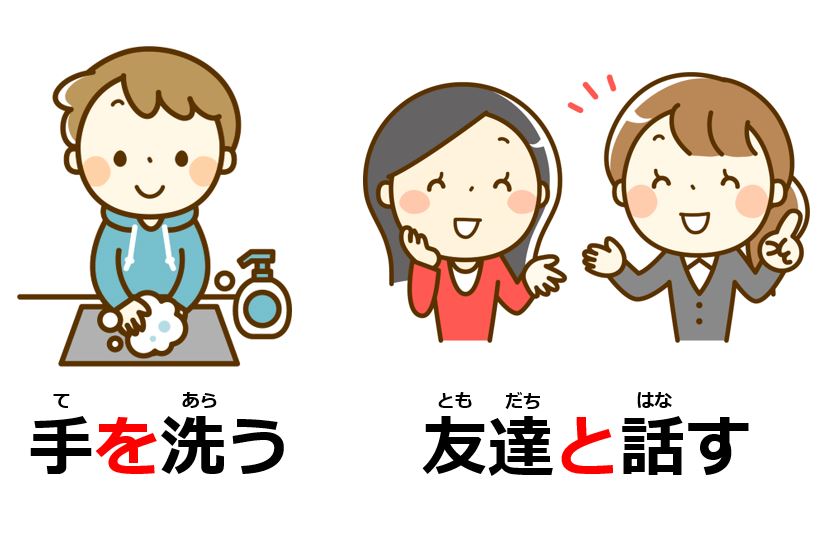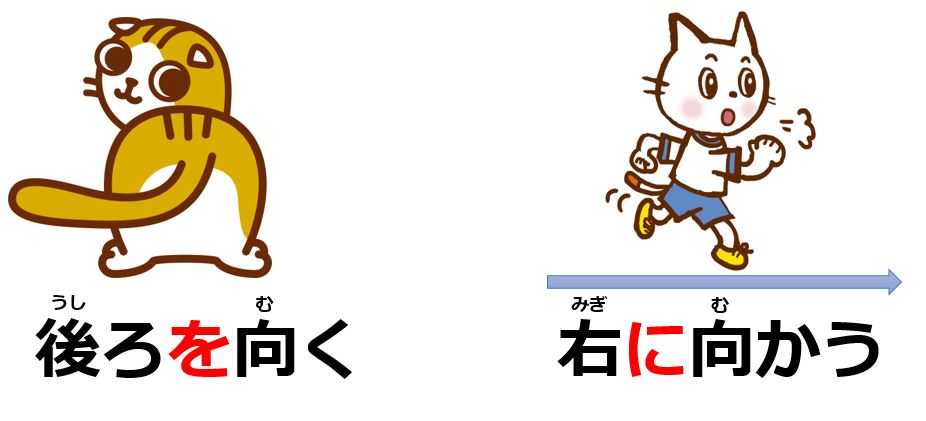Last time, you learned how to make subjects of Japanese verbs with the particles が and は: 雨が降る (new information) and 雪は降らない (contrast). In this lesson, you will learn how to make objects of Japanese verbs by using the particles: を, に, and と.
How to Set Objects with the Particle を, に, and と
| Table of Contents What Is a Complete Sentence Like? The particle を The particle に The particle と |
Unlike intransitive verbs like “走る: to run” and “歩く: to walk,” transitive verbs like “食べる: to eat” and “飲む: to drink” have to have objects. When you make objects of Japanese verbs, you need to select a suitable particle among from を, に, and, と. Each function is different. Let’s go over them one by one.
What Is a Complete Sentence Like?
As you already know, sentences without subjects are very common in Japanese. In addition to that, objects can be omitted when the context is clear. Take a look at the following examples.
| 会う / 会います。 [I will] meet [him/her]. *Said when someone asked you “Will you meet your teacher?” |
| 食べる / 食べます。 [I will] eat [it]. *Said when someone asked you “Will you eat this fruit?” |
These are very natural expressions in Japanese. Now, do you remember how to conjugate them? Let’s make them the negative form as a review.
| 会わない / 会いません。 [I will] not meet [him/her]. |
| 食べない / 食べません。 [I will] not eat [it]. |
Particles Will Be Determined Based on What the Objects Are
In English, with the sentences: “I will eat apple” and “I will meet my mother,” “apple” and “mother” can be just categorized into objects. However, you cannot use the same particle for those objects in Japanese. Let’s break down objects in Japanese grammar.
The Particle を
を is pronounced as お and placed after objects. In Japanese, the sentence order should be like this: Topic + Subject + Object + Verb. Although omissions may cause confusion, the basic order will remain the same.
Direct Object
| [私は / が] | 本を | 読む / 読みます |
| [Topic / Subject] | Direct Object | Verb |
| [I will] read a book. | ||
The first function of を is to express direct objects. This usage is very simple. Here are more examples.
| 車を(洗う / 洗います)。 [I will] wash the car. |
| 窓を(開ける / 開けます)。 [I will] open the window. |
| 歌を(歌う / 歌います)。 [I will] sing a song. |
| 本を(売る / 売ります)。 [I will] sell books. |
| 鞄を(置く / 置きます)。 [I will] put [my] bag down. |
| 家を(買う / 買います)。 [I will] buy a house. |
Location to Leave
| [私は / が] | 家を | 出る / 出ます |
| [Topic / Subject] | Location to Leave | Verb |
| [I will] leave [my] house. | ||
The second function is to express where you leave. The locations can be not only actual locations, but also organizations as well. Some intransitive verbs can appear with を in this context, which you will learn in another lesson.
| バスを(降りる / 降ります)。 [I will] get off the bus. |
| 日本を出発(する / します)。 [I will] depart from Japan. |
| 大学を卒業(する / します)。 [I will] graduate from the university. |
| 仕事を(やめる / やめます)。 [I will] quit [my] job. |
| アルバイトを(休む / 休みます)。 [I will] be absent from [my] part-time job. |
Location to Pass
| [私は / が] | 階段を | 登る / 登ります |
| [Topic / Subject] | Location to Pass | Verb |
| [I will] go up the stairs. | ||
The third function is to express where you pass through. The is applicable not only actual locations, but also situations of locations and time as well.
| 橋を(渡る / 渡ります)。 [I will] cross the bridge. |
| カフェを(通る / 通ります)。 [I will] pass a café. |
| 交差点を(曲がる / 曲がります)。 [I will] turn at the crossroad. |
| 虫が空を(飛ぶ / 飛びます)。 The insect [will] fly in the sky. |
| 雨の中を(走る / 走ります)。 [I will] run in the rain. |
| 幸せな時間を(過ごす / 過ごします)。 [I will] have a good time. |
Direction of Action
| [私は / が] | 上を | 見る / 見ます |
| [Topic / Subject] | Direction of Action | Verb |
| [I will] look up. | ||
The last function is to express the direction of actions. を can be directly attached with words which mean directions itself like “北: north” and “下: below.” If you would like to say “direction of …”, you need to put …の方 as the following examples show.
| 右を(向く / 向きます)。 [I will] turn right. |
| 学校の方を(見る / 見ます)。 [I will] look in the direction of the school. |
[adsense]
The Particle に
に has a lot of functions. Here, we will show you only the ones related to verbs. You will learn the rest in other lessons.
Direction of Motion
| [私は / が] | 北に | 行く / 行きます |
| [Topic / Subject] | Direction of Motion | Verb |
| [I will] go toward the north. | ||
The first function is to express the direction of motions. Just like the particle に, when you use words which don’t directly mean directions, you need to use …の方 as well.
| 東に(向かう / 向かいます)。 [I will] head to the east. |
| 右に(曲がる / 曲がります)。 [I will] turn right [at the corner] . |
| 海の方に(行く / 行きます)。 [I will] go in the direction of the sea. |
This may sound similar to the particle を (the direction of actions). The difference is in whether you will physically move or not. That is to say, when you use を (the direction of actions), your body, i.e. your feet, won’t move. When you use に (the direction of motions) , your body, i.e. your feet, will move.
In this context, に is interchangeable with the particle へ. Note: when へ is used as a particle, you have to pronounce it as え.
| 東へ(向かう / 向かいます)。 [I will] head to the east. |
| 海の方へ(行く / 行きます)。 [I will] go in the direction of the sea. |
Destination
| [私は / が] | 東京に | 行く / 行きます |
| [Topic / Subject] | Destination | Verb |
| [I will] go to Tokyo. | ||
The second function is to express destinations. In this context, に is interchangeable with the particle へ, too.
| 学校に(行く / 行きます)。 [I will] go to school. |
| 駅に(着く / 着きます)。 [I will] arrive at the station. |
| 家へ (来る / 来ます)。 [Someone will] come to [my] house. |
| 国へ(帰る / 帰ります)。 [I will] return my home country. |
Target (Indirect Objects)
| [私は / が] | 数学を | 弟に | 教える / 教えます |
| [Topic / Subject] | Direct Object | Target | Verb |
| [I will] teach mathematics to my younger brother. | |||
The third function is to indicate targets (indirect objects). This is mostly used when you give or do something for someone. Regarding the sentence order, the を part and the に part can be replaced.
| パソコンを先生に(渡す / 渡します)。 [I will] hand over [my] PC to [my] teacher. |
| 手紙をお母さんに(送る / 送ります)。 [I will] send a letter to [my] mother. |
| お父さんにプレゼントを(買う / 買います)。 [I will] buy a present for [my] father. |
| 姉に本を(売る / 売ります)。 [I will] sell the book to [my] elder sister. |
The difficult point here is how to identify the proper particle between direct objects and targets (indirect objects), especially when there is only one object. Take a look at the following.
| 子供 に・ [I will] meet children. |
| 先生 に・ [I will] consult with the teacher. |
| 肩 [I will] tap [someone] on the shoulder. |
| 妹 [I will] scold [my] younger sister. |
Some say that you need to judge it based on whether objects are direct or indirect. However, that border is not completely defined. Thus, you need to memorize the combinations with verbs respectively.
The Particle と
This is the last particle which you need to learn in the verb section. Take it easy. The usage is very simple.
Partner of Interaction
| [私は / が] | 鈴木さんと | 遊ぶ / 遊びます |
| [Topic / Subject] | Partner of Interaction | Verb |
| [I will] hang out with Suzuki-san. | ||
The first function is to express partners of interaction. Some verbs can be used with both the particle に expressing targets and the particle と. The difference of the nuance will be whether it is interactive or one-sided actions like this:
| 野村さんに(話す / 話します)。 [I will] tell Nomura-san. |
| 野村さんと (話す / 話します)。 [I will] converse with Nomura-san. |
Here are more examples. They require the particle と because “to marry” and “to quarrel” must be interactive actions.
| 彼女と結婚 (する / します)。 [I will] get married to my girlfriend. |
| 彼氏とケンカ(する / します)。 [I will] quarrel with my boyfriend. |
The particle と can be also used to express just partners.
| 小林さんと映画を(見る / 見ます)。 [I will] see a movie with Kobayashi-san. |
| 彼女と学校に(行く / 行きます)。 [I will] go to school with my girlfriend. |
Object of Similarity / Difference
| [私は / が] | みんなと | 違う / 違います |
| [Topic / Subject] | Object of Difference | Verb |
| [I] differ from everyone. | ||
Another function is to indicate an object’s similarities or differences.This can be used with adjectives as well. In the following example, 同じ is an adjective, but can have an object.
| 私の意見は彼の意見と(異なる / 異なります)。 My opinion differs from his. |
| 私のノートは彼のノートと同じ(だ / です)。 My notebook is the same as his. |
Summary
- The particle を can express;
- Direct Object
- Location to Leave
- Location to Pass
- Direction of Action
- The particle に can express;
- Direction of Motion
- Destination
- Target (Indirect Object)
- The particle と can express;
- Partner of Interaction
- Object of Similarity or Difference
In this article, you have learned a lot about particles. You might get confused with the usages. Don’t worry. You have already completed 50% of the Japanese particles and, as you proceed with your learning, you will clear up any doubts you may have. From now on, you will learn the rest of the Japanese particles.

Subjects of Japanese Verbs with the Particles: は and が

Particle で: Expressing Supplementary Information




